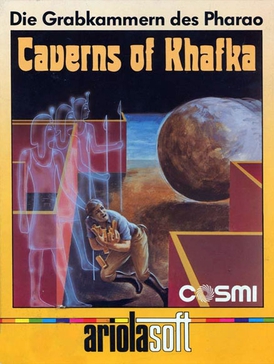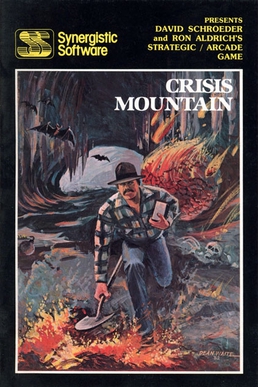
Prince of Persia is a cinematic platform game developed and published by Broderbund for the Apple II in 1989. It was designed and implemented by Jordan Mechner. Taking place in medieval Persia, players control an unnamed protagonist who must venture through a series of dungeons to defeat the evil Grand Vizier Jaffar and save an imprisoned princess.

Lode Runner is a 2D puzzle-platform game, developed by Doug Smith and published by Broderbund in 1983. Its gameplay mechanics are similar to Space Panic from 1980. The player controls a character who must collect all the gold pieces in a level and get to the end while being chased by a number of enemies. It is one of the first games to include a level editor.

Tempest is a 1981 arcade video game by Atari, Inc., designed and programmed by Dave Theurer. It takes place on a three-dimensional surface divided into lanes, sometimes as a closed tube, and viewed from one end. The player controls a claw-shaped "blaster" that sits on the edge of the surface, snapping from segment to segment as a rotary knob is turned, and can fire blaster shots to destroy enemies and obstacles by pressing a button.

Barbarian: The Ultimate Warrior is a 1987 video game developed and published by Palace Software for the Amstrad CPC, Commodore 64, and ZX Spectrum. The game was ported to many other systems and was licensed to Epyx who published it as Death Sword in the United States.
Fueled by the previous year's release of the colorful and appealing Pac-Man, the audience for arcade video games in 1981 became much wider. Pac-Man influenced maze games began appearing in arcades and on home systems. Pac-Man was the highest grossing video game for the second year in a row. Nintendo's Donkey Kong defined the platform game genre, while Konami's Scramble established scrolling shooters. The lesser known Jump Bug combined the two concepts into both the first scrolling platform game and the first platform shooter. Other arcade hits released in 1981 include Defender, Frogger, and the Galaxian sequel Galaga.

Beyond Castle Wolfenstein is a 1984 World War II stealth game. A direct sequel to Castle Wolfenstein, it is the second game in the Wolfenstein series, and the last installment to be released by original developer Muse Software before the name was revived for a first-person shooter in 1991. Castle Wolfenstein was written solely by Silas Warner for the Apple II, while the sequel was developed simultaneously for the Apple II and Commodore 64 by Warner, Eric Ace, and Frank Svoboda III. It was quickly ported to the Atari 8-bit computers and MS-DOS.

H.E.R.O. is a video game designed by John Van Ryzin and published by Activision for the Atari 2600 in March 1984. It was ported to the Apple II, Atari 5200, Atari 8-bit computers, ColecoVision, Commodore 64, MSX, and ZX Spectrum.

Montezuma's Revenge is a platform game for the Atari 8-bit computers, Atari 2600, Atari 5200, Apple II, ColecoVision, Commodore 64, IBM PC, and ZX Spectrum. It was designed and programmed by Robert Jaeger and published by Parker Brothers in 1984. The game's title references a colloquial expression for diarrhea contracted while visiting Mexico.
Synapse Software Corporation was an American software developer and publisher founded in 1981 by Ihor Wolosenko and Ken Grant. Synapse published application software and developer tools and was primarily known for video games. It initially focused on the Atari 8-bit computers, then later developed for the Commodore 64 and other systems. Synapse was purchased by Broderbund in late 1984 and the Synapse label retired in 1985.

Myth: History in the Making is a 2D platform game developed and published by British publishing house System 3 for the Commodore 64, Amiga, Amiga CD32, Amstrad CPC and ZX Spectrum. It was also released on the NES as Conan: The Mysteries of Time. It was officially announced for Atari ST and a preview version was available, but the full version was never released.

Indiana Jones and the Temple of Doom is an action game released in 1988 for the Nintendo Entertainment System. The game is based on the arcade game and film of the same name. The resulting product differed from the arcade version in several aspects, but kept the same underlying premise and style.

Sword of Sodan is a hack and slash video game released for the Amiga in 1988 by Discovery Software, which also commissioned a port for the Apple IIGS. A scaled-down version for the Sega Genesis was released in 1990 by Electronic Arts, and in 1993 it was released for the Apple Macintosh System 7 by Bethesda Softworks.

Indiana Jones and the Temple of Doom is an action video game developed and published by Atari Games and released in arcades in 1985. It is based on the 1984 film of the same name, the second film in the Indiana Jones franchise. It is the first Atari System 1 arcade game to include digitized speech, including voice clips of Harrison Ford as Indiana Jones and Amrish Puri as Mola Ram, as well as John Williams's music from the film.

Unreal is a video game released by Ubi Soft for the Amiga in 1990. The game, divided in 8 chapters, combined two different genres: In five levels, the player controls a pterodactyl-like creature in a pseudo-3D rail shooter environment. Three levels are side-scrolling platform games where the player controls a barbarian fighting monsters and solving puzzles. Ports for MS-DOS compatible operating systems and Atari ST were released in 1991.

Rastan Saga, known as Rastan in North America, is a side-scrolling hack and slash arcade video game released by Taito in 1987. It was a critical and commercial success and was ported to home platforms.

Caverns of Khafka refers to either of two platform video games published by Cosmi. In both game versions the player takes control of a treasure hunter in search for the fabled treasure of Pharaoh Khafka. The first game was created by Robert T. Bonifacio and released in 1983 for Atari 8-bit computers. Subsequently, a different game with the same title and overall theme was created by Paul Norman and released for the Commodore 64 in 1984.

Crisis Mountain is a platform game written by David H. Schroeder for the Apple II and published by Synergistic Software in 1982. A port to Atari 8-bit computers was released in 1983. Creative Software published cartridge versions for the Commodore 64 and VIC-20. Ports for the FM-7 and PC-8800 series were from Comptiq.

Danger Ranger is a non-scrolling platform game designed by Ken Kalish and published in 1983 by Microdeal for the Dragon 32/64 and TRS-80 Color Computer. The game was ported to the Atari 8-bit computers and Commodore 64 by Rita Jay in 1984.

















